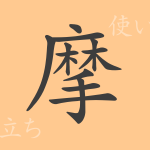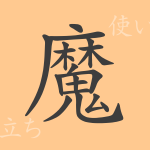The written culture of Japan runs deep, and among its characters, kanji (漢字) are known for their complexity and beauty. The common-use kanji “磨” (みが) symbolizes concepts rooted in our daily lives, ranging from physical polishing to spiritual growth. In this article, we delve into the origins, usage, and even proverbs and idioms featuring “磨” (みが), exploring its charm in depth.
Origins of 磨 (みが) (Etymology)
The kanji “磨” (みが) evolved from ancient Chinese words that meant to grind or polish stones. The original pictograph combined the shapes of a tool for grinding stones and a hand using it. Over time, this kanji came to signify not only physical polishing but also spiritual refinement. In Japan, this kanji is used in various contexts and is deeply related to Japanese life and values.
Meaning and Usage of 磨 (みが)
“磨” (みが) is primarily used to mean “to wear down,” “to bring out a shine,” or “to polish.” Physically, it is used in everyday scenes like brushing teeth or polishing shoes. Spiritually, it is used to express the improvement of skills or character, such as “to hone one’s skills” or “to refine one’s mind.” Thus, “磨” (みが) is a versatile kanji encompassing both concrete actions and abstract concepts.
Reading, Stroke Count, and Radical of 磨 (みが)
The reading and components of the kanji “磨” (みが) are important points in Japanese writing.
- Reading: On’yomi (音読み) is “マ” (ma), Kun’yomi (訓読み) is “みがく” (migaku) and “する” (suru)
- Stroke count: 16 strokes in total
- Radical: 石部 (いしへん) (ishihen – stone radical)
Idioms, Proverbs, and Sayings Featuring 磨 (みが) and Their Meanings
Idioms, proverbs, and sayings that include “磨” (みが) enrich the Japanese language with their symbolic meanings. For instance, “磨穿鉄硯” (ませんてっけん) (masen tekken) is a proverb that illustrates how persistent effort can overcome even the most challenging obstacles. Additionally, “心を磨く” (こころをみがく) (kokoro wo migaku) is an idiom used to mean enhancing one’s character or spirituality. These expressions symbolize the Japanese values of effort and perseverance, remaining beloved by many even today.
Summary of 磨 (みが)
The kanji “磨” (みが) symbolizes the beauty of the Japanese language in both its form and meaning. From the act of polishing materials to the growth of the human spirit, “磨” (みが) holds a broad spectrum of meanings and is deeply ingrained in Japanese life and culture. Through this exploration, we have come to understand the diverse aspects of “磨” (みが) and appreciate how much weight this single character adds to our language.
“`

























